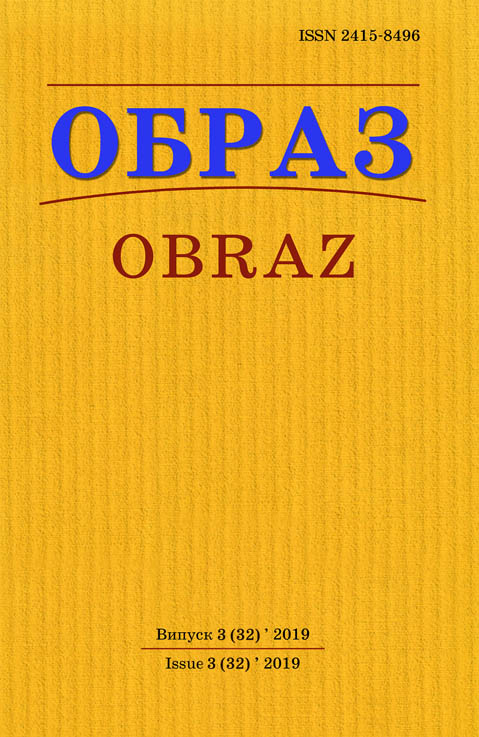Abstract
Introduction. Research on live broadcasting television and interactive projects is an important contribution not only to the history and theory of social communications, but also a promising field for further research of this type of broadcasting that can be also eapplied to the investigation of the Internet. Generalization and distinguishing features of this type of broadcasting are less common in the scientific community. During the research the following methods were used: historical and historical comparative to analyze and organize data concerning ways of live broadcasting and interactive programs formation; systematization, classification and clustering methods were used to get generalizations. Comparative method was implemented to distinguish common and diverse features of different types of broadcasting which are used in broadcast journalism. Content analysis method was applied for organization of data concerning the development of programs which use interaction with the viewer as a certain communicative technology. The purpose of our study is to formulate a certain concept of genre features which are typical for interactive and live television broadcasting. We set out the following tasks: to distinguish the features of interactive and live broadcasting; outline their particularities in different types of broadcasting and offer promising directions for using that type of broadcasting. This allowed us to distinguish the difference between live and interactive broadcasting, to focus on time and duration of interaction, to trace the use of different genres in these types of programs, to distinguish their specific features, to generalize and classify them, to identify promising directions of research. Results and conclusions. Live interactive television is characterized by a genre-themed variety. Language communication and an improvisational script are mainly used in live broadcasting that motivates the audience to engage, provides lasting interest, trust and positive changes in the image of the channel. News uses live broadcasting as the main way of organization of information (using «live» or stream of momentous events broadcasting), the use of interactivity in this type of broadcasting is indirect and is more oriented to further communication using individual touch points. Analytical programs are represented by various conversations in studio and telemarathon. Viewer interaction is limited to «viewer as one of the audience» type. Entertainment broadcasting is presented in such formats as Life-Show, Reality-Show (one of its varieties is Talant-Show) and Intelligence-Show, where interaction with the viewer is one of the formative factors. We see the benefits of this type of television among other forms of broadcasting in economic, dramatic, ideological and communication aspects.
References
1. Akhvlediani M. V. (2004) Novosti – nasha professiya. [News is our profession]. Moscow, Russia.
2. Boretskiy R. A. (1967) Televizionnaya programma : ocherk teorii propagandy. [Television program: essay on the theory of propaganda]. Moscow, Russia.
3. Vstanovlenyy novyy svitovyy rekord u telebachenni! (2011) [A new world record in television is set!]. available at: https://www.5.ua/suspilstvo/vstanovlenyi-novyi-svitovyi-rekord-utelebachenni-38605.html (access: October 21, 2019). Ukrainian.
4. Horodenko L. M. (2012) Teoriya merezhevoyi komunikatsiyi: Monohrafiya [The theory of network communication: Monograph] / Za zahal. nauk. red. V. F. Ivanova. – Kyiv: Akademiya Ukrayinskoyi Presy. Ukrainian.
5. Hoyan V. V.(2011) Zhurnalistska tvorchist na telebachenni : monohrafiya [Journalistic creativity on television: a monograph]. Kyev: Kyev. Univ. Ukrainian.
6. Dobrova S. (2016) Novitni pidkhody do vyvchennya internet-telebachennya [New Approaches to Studying Internet Television].Tele- ta radiozhurnalistyka. Zbirnyk naukovykh prats / Lviv. Vol.16. pp.162-167/ Ukrainian.
7. Materialy Pervogo i Vtorogo Mezhdunarodnykh kongressov Yevraziyskogo Teleforuma (2003) / pod red. V. Ruzina. Materials of the First and Second International Congresses of the Eurasian Teleforum / ed. V. Ruzina. Moscow, Russia.
8. Mashchenko I. H. (2006). Entsyklopediya elektronnykh mas-media.[Encyclopedia of electronic media] (Vol. 1). Zaporizhzhya : Dyke Pole, Ukrainian.
9. Mashchenko I. H.(2001) Mify ta realiyi teleradioefiru [The myths and realities of broadcasting]. Kyev: Ahent•stvo TRK, Ukrainian
10. Novitni tekhnolohiyi teleradiomovlennya: svitovyy dosvid (materialy naukovoho kolokviumu, Kyyiv, 16 lystopada 2011 r. [New technologies of broadcasting: world experience (materials of scientific colloquium, Kyiv, November 16, 2011]: za zah. red. V. V. Rizuna, Kyyivskyy natsionalnyy un-t im. Tarasa Shevchenka, In-t zhurnalistyky ; Teleradioklub / Peredmova ta uporyadkuvannya V. V. Hoyan. available at: http://journlib.univ.kiev.ua/Books/ Novitnitekh.pdf (access: October 21, 2019). Ukrainian.
11. Polisuchenko A. Y. (2013) Interaktyvnist u televiziynomu movlenni Ukrayiny: teoriya i praktyka [Interactivity in Ukrainian Television Broadcasting: Theory and Practice]. (Candidate’s thesis).Kyiv. [in Ukrainian].
12. Pocheptsov G. G. (2001) Teoriya kommunikatsii. [Theory of communication.] Moscow : Refl-buk; Kyev : Vakler, Russia.
13. Televizionnaya zhurnalistika : uchebnik. (2005) [Television journalism: a textbook] Moscow : Izd-vo Mosk. un-ta : Nauka, Russia
14. Tsvik V. L. (2009) Televizionnaya zhurnalistika. [Television journalism] Moscow : YUNITIDANA, Russia.
15. Eko U. (2006) Otkrytoye proizvedeniye [The Open Work] : avtoriz. per. s ital. (A. P. Shurbeleva, Trans.). St. Petersburg: Symposium, Russia.
16. Delestage, Charles-Alexandre (2018). L’expérience émotionnelle ou la performance des programmes de télévision : l’horizon de pertinence comme déterminant de la construction de sens par le spectateur. available at: http://www.theses.fr/2018VALE0026/document. (access Оctober 21, 2019)
17. Hollander R. S. Video Democracy. The vote – from Home Revolution / R. S. Hollander. – Mt. Airy (Md.) : Lomond, 1985. – 167 p.
18. Rassel N. W. The Psychology of the New Media / N. W. Rassel // Television for the 21 Century. The New Wave. – Washington : D. C., 1993.
19. Scott, Fiona (2018) Young children’s engagement with television and related media in the digital age. PhD thesis, University of Sheffield. available at: http://etheses.whiterose. ac.uk/22928/1/Scott_F_PhD_Thesis_LibraryCopy.pdf (access Оctober 21, 2019).

This work is licensed under a Creative Commons Attribution 4.0 International License.

